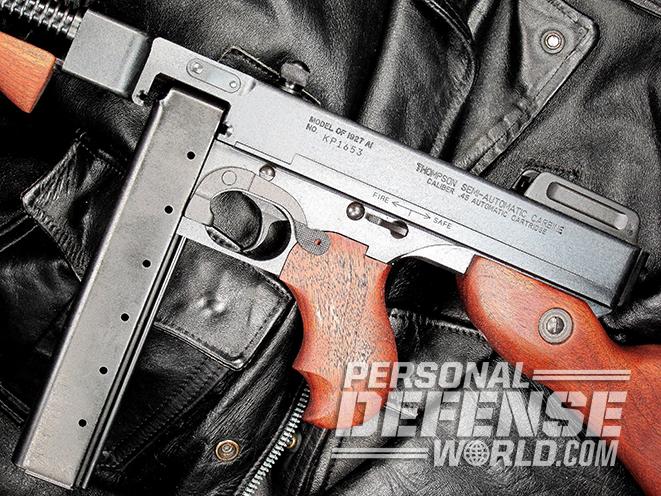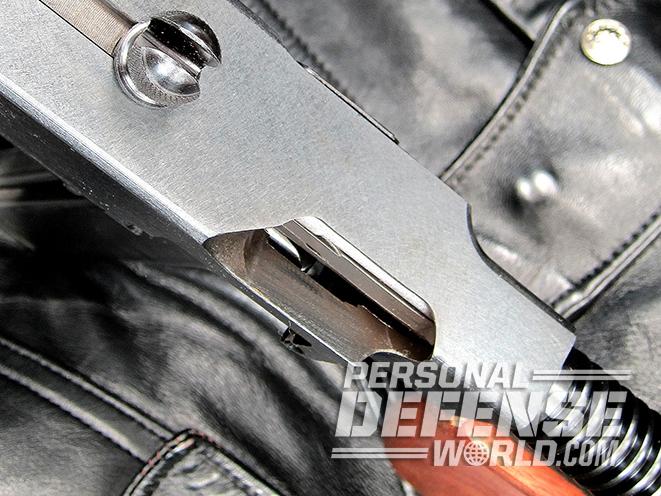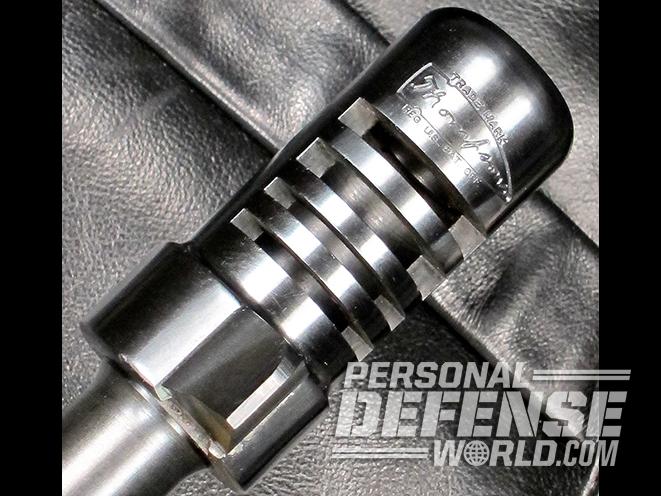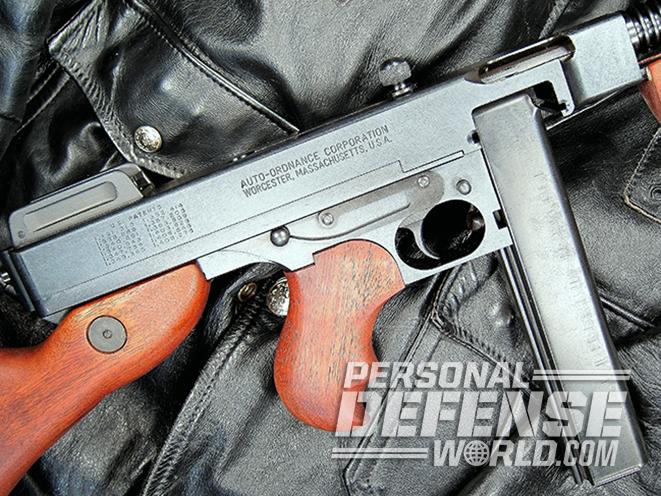Few firearms in the history of gunpowder require less introduction than the famed Tommy gun, a major player on both the battlefields of WWII and the mean streets of gangland Chicago. We all know the Thompson’s history in the hands of good guys and bad, we all know the full-auto Thompson is long obsolete in its original roles as both trench and street sweeper, hideously expensive, not likely to ever be available to the common man or woman again in brand-new form, and relegated to the collector and the wistful wannabe collector. Count me among that latter category by the way. So, given that, let’s move forward.
Semi-Auto Variants

The Thompson remains a legendary and iconic weapon, retaining sufficient appeal for Auto-Ordnance to keep on trucking, year after year, with its line of semi-auto configurations that carry on the legend (at least in appearance) without mortgaging the house to acquire. The guts may have been de-auto’d, the barrels may have been extended, and the selector switch may have been reduced to two positions instead of three, but the unmistakably quintessential Tommy gun profile is still instantly recognizable.
Advertisement — Continue Reading Below
What’s the appeal of a heavy walnut-dressed chunk of solid-steel .45 ACP firepower in a subgun that’s not really a subgun in today’s market dominated by featherweight plastics and alloys? Simple. It’s the closest most of us can come to the “real thing.” It looks like a Tommy gun, it feels like a Tommy gun, and it throws a big slug like a Tommy gun, even if it does only toss those slugs out one at a time per trigger pull. All things considered (collector pricing, federal paperwork hassles and the cost of actually firing a 600-rpm submachine gun), a semi-auto-only version of this hundred-year-old design makes sense to those who want a landmark piece of history to heft, fire and show off at the range.
Barrel Length

You’re probably enough of a gun person to be aware that your friendly federal government takes a dim view of rifles with barrels less than 16 inches long. This is a nuisance to the purists who know that the original Thompsons had barrels of either 12 inches with Cutts compensators or 10.5 inches without, but to avoid Class III NFA restrictions, these semi-auto Thompsons are fitted with 16.5-inch barrels.
This has been the main gripe about the semi-auto Thompsons ever since they were first introduced—a clear case of the Just Doesn’t Look Right Syndrome compounded by extra ounces of unnecessary steel out front that make a heavy gun even heavier. In the standard Deluxe 1927A1 configuration that Auto-Ordnance has sold for many years, the 16.5-inch barrel had an additional inch and a half added to the muzzle with the screw-on Cutts compensator that completed the classic “gangster” profile and brought the actual barrel length to 18 inches overall.
Advertisement — Continue Reading Below
Since 18 inches that really should be 12 continues to annoy some buyers, and nobody removes that compensator to leave bare muzzle threads hanging out anyway, in 2016, Auto-Ordnance created a new model designated the T1-14. This one ships with a 16.5-inch overall barrel length in 1927A1 form, but that 16.5 inches includes a permanently attached, non-removable Cutts compensator as a part of its total length. The feds call for a minimum of 16 inches of something out front, but it doesn’t all have to be a rifled tube. Flash suppressors, muzzle brakes, compensators and so on can make up a part of those 16 inches as long as they can’t be removed to create a short-barreled rifle (SBR) falling under the National Firearms Act of 1934.
So, this new Tommy gun is 1.5 inches shorter than the older Auto-Ordnace 1927A1s. Does that game-change the world as we know it? For most, probably not. For many, maybe. For some, definitely. I’ve worked with Auto-Ordnance Tommy guns before, and I’m not shy about saying anything that trims an ounce or two off these guns, without altering the looks or the quality, is OK by me.
More Details

The 1927A1 T1-14 is one solidly reassuring mass of walnut and steel, unapologetically without a single piece of plastic in or on it anywhere. At 12.5 pounds unloaded, even before you insert a 10-, 20- or 30-round stick magazine, or a 10-, 50- or 100-round drum magazine (the 1927A1 can accommodate both), there’s no doubt when you pick one up that this baby’s built for the long haul.
Advertisement — Continue Reading Below
The 1927A1 T1-14 model starts with that distinctive milled and welded Cutts compensator up front, designed to reduce muzzle rise under extended bursts of full-auto fire by diverting gases up through four wide slots on top to push the muzzle down while firing. Barrel fins behind it help with air cooling—useful again for high firing rates. The upper and lower receiver sections slide apart for maintenance by pushing a takedown button at the back end of the upper receiver.
The carbine’s steel sights are large and sturdy, with a front post dovetailing longitudinally into the compensator and a rear ladder sitting inside tall protective walls. The ladder is graduated out to 600 yards, but if you try to hit anything that far out, you’ll be doing it with a helluva lot of luck. The marked graduations don’t necessarily match up with exact distances anyway. When folded down, the rear sight displays a basic notch “blade” for close-in aiming, and the ladder’s sliding aperture provides a much-improved sight picture.
The 1927A1 furniture is oil-finished walnut. When the semi-auto Thompsons were first introduced several years back, surplus parts from old stockpiles were used where possible until supplies ran out. Today, all three wood elements are newly made, and the commercial steel buttplate does not have a cleaning kit trapdoor. But the fit and finish on the foregrip, pistol grip and stock are well done, showing some nice grain here and there.
Advertisement — Continue Reading Below
The controls include a left-side, two-position safety above and behind the trigger, and a large pivoting magazine release arm directly above the trigger. The original full-auto submachine guns fired from an open bolt, but the semi-auto Thompsons fire from a closed bolt. There’s no way to manually lock the bolt back without a magazine inserted, and the only way to release the bolt after it’s locked itself back on the last round in an empty mag is to remove that mag and retract the bolt slightly via the knurled cocking knob on top. Empty cases are ejected through a long port on the right half of the upper receiver, above the magazine cutout.
Heavy Hitter

We’ve all seen war movies, old and new, where Tommy-toting GIs hauled their subguns all over Europe and the South Pacific, lightly waving them around like they were 3-pound toys. The same goes for a number of old gangster epics. I freely admit that I’m not their equal; the 1927A1 is heavy, and that big blowback-operated bolt needs a strong spring to control it while cycling. Between the weight and the spring, this gun makes you work for your fun.
But it’s still fun, and the critter does give you a first-hand feel for at least a part of what the Tommy gun’s practitioners must have gone through in carrying, feeding and firing them. Obviously, the full-auto Thompson is a different animal once the trigger’s pulled, but you see how the semi-auto hefts and handles, and you begin to appreciate what it was like to make your living with one way back when.
Advertisement — Continue Reading Below
I ran five commercial loads through the 1927A1 off a sandbag rest at 50 yards. Right off the bat, the simple rear notch showed itself to be useless—too close for a notch, my eye just couldn’t focus on it. Raising the ladder, the aperture gave a very good sight picture with the front post, looking through the split cocking knob. The lowest setting created holes several inches below the point of aim at that 50-yard distance, and it took some experimentation to find a setting that mated the point of aim to the point of impact. Fortunately, there is plenty of room for elevation adjustments with this sight if you need them.
The original Thompson was designed around a 230-grain FMJ military load, and the various generations of semi-auto Thompsons in recent years have been spotty in functioning with anything but 230-grain FMJs. My test ammo here included two different-weight FMJs (brass-cased Blazer 230-grainers and Winchester 185-grainers), two jacketed hollow points (Winchester 230-grain PDX1s and Hornady 185-grain Critical Defenses) and Federal’s interesting 230-grain American Eagle polymer-coated Syntech range ammo.
While the current semi-auto Thompsons appear to be more hollow-point-friendly, the only way to tell for sure if the gun you buy will function with them reliably is to test a box or two. The two FMJs fed and cycled perfectly, as expected, even in the lighter bullet weight. The same went for the light Hornady JHPs. The American Eagle load was noticeably lighter in recoil energy but still cycled through without a hitch. The polymer coating on these Syntech bullets is designed to eliminate metal-on-metal contact while chambering, and even though it’s a light load, it was strong enough to deal with the Thompson’s heavy mainspring.
Advertisement — Continue Reading Below
The only failure during the test session was the second Winchester PDX1 JHP I fired, which produced a feed ramp hang-up, but all of the following PDX1s ran fine. Generally speaking, the bullet nose profile is probably the most important factor in ammo compatibility. A hollow point with a rounded nose and a “wrapped-over” jacket edge should feed well—better than a squared-off nose with a sharp jacket edge that can dig into the feed ramp.
Once I got the rear aperture set for 50 yards, the 1927A1 showed it was capable of holding under 2 inches for three-shot groups with the premium hollow points, and surprisingly the same with the Winchester “White Box” FMJ practice loads. The brass-cased Blazers opened up but still held under 3 inches, and the Thompson showed that it might feed the American Eagle Syntech rounds just fine, but they wouldn’t shoot worth a hoot for accuracy through the long rifle barrel. Overall, the gun scores well in both reliability and accuracy with the right ammunition.
Tommy Gun Fun For All

As mentioned, the gun was heavy, and it was awkward to manipulate. But, as a plus, there wasn’t much recoil thanks to the gun’s weight and the effective compensator. If you can shoot a .22, you can shoot this Thompson. The strong mainspring, coupled with a too-small cocking knob, can make manually retracting the bolt a problem, and it might be impossible for some shooters. To put it bluntly, it’s a bear to haul that bolt back far enough to lock it open on an empty magazine or manually cock it to begin with; the cocking knob really needs to be about twice its size, and its sharp edges should be dehorned. As far as overall handling goes, however, the gun’s easy on the shoulder to shoot, but not pleasant to lug around or operate the action.
Advertisement — Continue Reading Below
Also, you won’t be reloading quickly here. My shooting thumb can’t reach the magazine release, so it requires both hands to remove the 30-round stick mag shipped with the 1927A1, with the left hand working the release. On inserting a loaded magazine, you have to depress the release arm to let it slide on by, so again it’s a relatively slow process. This isn’t a critical operational flaw, just a part of the classic design’s personality.
The fit and finish are both very well done, with nicely formed wood, cleanly machined flats and corners, evenly stamped markings, no-wobble mating between the upper and lower receivers, and uniform bluing throughout. The trigger pull does take a while to get from here to there, and it’s off my 8-pound scale but smooth en route. The foregrip is quite comfortable, as is the trigger reach with the pistol grip. The safety is reachable with the right-hand thumb, the stock length was just right for me, and the steel buttplate wasn’t even noticed under the gun’s mild recoil.
The Thompson was a ground-breaking design for its time, and even though that time as a practical working subgun has long since passed into history, these semi-autos are still a link to legend and lore, and they make fun plinkers on paper targets and soda cans. The test sample was the best of the semi-auto Thompsons I’ve worked with, and if the idea intrigues you, check out all the versions Auto-Ordnance now offers, including short-barreled rifles and those with alloy frames and detachable stocks.
Advertisement — Continue Reading Below
These Tommy guns aren’t cheap, but nowadays, no rifle made this way is, and the company carries an extensive line of spare parts to keep them going for a long, long time. Quirky? Maybe. Fun? Definitely.
Caliber: .45 ACP
Barrel: 16.5 inches
OA Length: 39 inches
Weight: 12.5 pounds (empty)
Stock: Walnut
Sights: Post front, ladder rear
Action: Blowback, semi-auto
Finish: Blued
Capacity: 10+1 to 100+1
MSRP: $1,583
For more information, visit auto-ordnance.com.

































